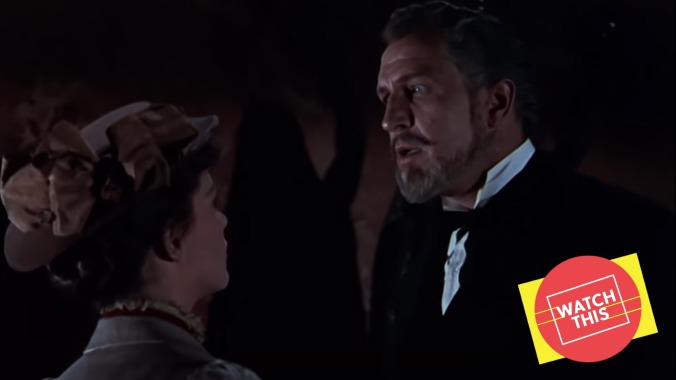House Of Wax unleashed the devilish horror star lurking within Vincent Price

Watch This offers movie recommendations inspired by new releases, premieres, current events, or occasionally just our own inscrutable whims. Because it’s Horror Week at The A.V. Club, we’re highlighting movies featuring major stars of the genre.
House Of Wax (1953)
By 1953, Vincent Price had spent 15 years acting in Hollywood, with considerable success. His urbane voice and appearance made him an ideal generic sophisticate, and he played memorable supporting roles in such classic dramas as Laura and Leave Her To Heaven; if you were to name a contemporary whose career closely resembled his up to that point, the most obvious choice would be George Sanders, best known as All About Eve’s unctuous theater critic. How, then, did Price eventually become so associated with horror that musicians like Alice Cooper and Michael Jackson tapped him to speak spooky monologues (on Welcome To My Nightmare’s “The Black Widow”and Thriller’s title track, respectively)?
House Of Wax is the movie that launched his second, more enduring phase of stardom. Price had occasionally turned up as villains before, but director Andre de Toth was the first to recognize just how creepy his patrician affect could be, and how potentially porous was the boundary between eccentric and insane. Professor Henry Jarrod, the curator of a wax museum, initially seems just a trifle weird, prone to treating his sculpted creations as if they were alive. After his business partner burns the place down for the insurance payoff, however, Jarrod—who barely survives the blaze—loses his mind, even as he retains the politesse and deliberate speech patterns that define a Vincent Price performance. He opens a new, “improved” House Of Wax, this time with a crowd-pleasing emphasis on the lurid and unspeakable. One wing is devoted to tableaux of murders that took place quite recently, featuring figures that, for all their waxy sheen, look suspiciously lifelike. And Jarrod still seeks his ideal model for Marie Antoinette…
Streaming House Of Wax at home does mean missing out on its original selling point: 3-D. It was the first color 3-D feature released by one of the major studios (as well as the first in stereophonic sound), and while it can be thoroughly enjoyed without the novelty of objects leaping into your lap, there are a few extended sequences—a barker with a paddleball, dancers kicking their legs toward the camera—that have no function whatsoever if you’re not wearing special glasses. (Writers are contractually obligated to note the irony that de Toth could not himself perceive 3-D, having lost the use of one eye. He’s the Beethoven of cinema.) While most film buffs remember that aspect, however, it’s easy to forget, all these decades later (when past eras tend to blend together) that House Of Wax is also a period piece, released in 1953 but set in 1902. That’s equivalent to a contemporary film being set in the 1970s, and just as we delight in the outmoded fashions and customs, so did audiences then. “If I don’t sizzle him tonight,” a young woman says, admiring an outfit that would have looked quite prim even at the time, “I might as well give up.” Two morgue attendants wheeling a body wonder aloud how a motor car could possibly move fast enough to kill anyone.
Unlike the lousy 2005 remake, which predictably found ways to introduce explicit gore (and which mostly terrified viewers via the prospect of Paris Hilton, actor), this House Of Wax relies primarily on shudders rather than active frights. Its most disturbing sequence, arguably, is the opening act of arson, which more or less prefigures what happens to the Nazis when they open the Ark Of The Covenant; knowing that the melting faces belong to dummies somehow doesn’t make the spectacle much less grotesque. In part, that’s because Price does such a superlative job of humanizing them, quickly creating an impression of Jarrod as the kind of person who thinks of inanimate objects as if they were his friends, or even his children. It’s his loss we feel. Later, when prospective Marie Antoinette model/victim Sue Allen (Phyllis Kirk) looks up at the House Of Wax’s new Joan Of Arc—her face allegedly designed from a newspaper photo of Sue Allen’s recently murdered roommate (Carolyn Jones, who’d go on to play Morticia on The Addams Family)—it’s primarily just the thought of the corpse beneath that gets under your own skin. Characters are occasionally in physical danger (a young Charles Bronson, still billed as Charles Buchinsky, plays Jarrod’s mute muscle), but true horror derives from the juxtaposition of composed behavior and obscene acts. No one delivered that combination better than Vincent Price.
Availability: House of Wax is currently available for digital rental and/or purchase via Amazon, Google Play, Apple, YouTube, Microsoft, Fandango, DirectTV, and VUDU.